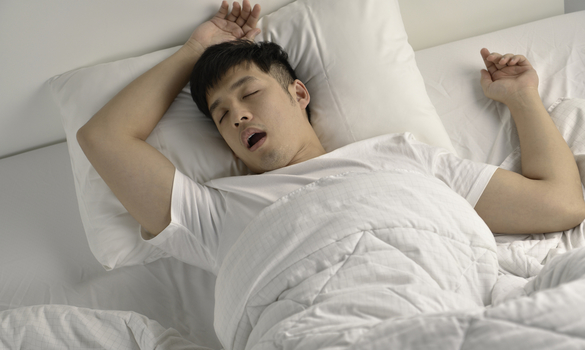
Continuous positive airway pressure for obstructive sleep apnoea (OSA) is often met with discomfort and compliance issues, while surgical treatment options fail to address the poor muscle tone that results in upper airway collapse during sleep. Discover hypoglossal nerve stimulation – a new therapy which addresses these limitations and offers durable, positive outcomes for OSA patients.
THE BURDEN OF OBSTRUCTIVE SLEEP APNOEA
Obstructive sleep apnoea (OSA) is a common, serious, and potentially life-threatening disorder characterised by recurrent episodes of upper airway obstruction during sleep that lead to hypoxemia and hypercapnia.
OSA is associated with substantial cardiovascular morbidity and mortality, endocrine disturbances, daytime somnolence, decreased quality of life, decreased cognitive function, decreased work productivity and motor vehicle crashes, hence increasing socioeconomic costs.
CURRENT GAPS IN OSA THERAPY
Effective treatment of OSA has been shown to improve quality of life, and decrease morbidity risk and its attendant healthcare costs.
The first-line gold standard therapy is the use of continuous positive airway pressure (CPAP) to act as a pneumatic stent to maintain airway patency. However, it is limited by poor patient acceptance with long-term adherence rates of only 39-60%. An audit conducted in Singapore General Hospital showed that 60-70% of patients diagnosed with OSA reject or are non-compliant to CPAP.
Individuals with symptomatic OSA who are CPAP-intolerant may opt to undergo upper airway reconstructive and ablative surgery. Multiple surgical procedures that modify soft tissues of the pharynx either by tissue reduction, stabilisation or advancement are available with an overall surgical success rate of 66.7%.
However, these procedures do not address the lack of muscle tone to maintain airway patency during sleep.
WHAT IS HYPOGLOSSAL NERVE STIMULATION?
The system comprises an implantable pulse generator (IPG), sensing lead and stimulation lead.

Figure 1 Implanted components of HGNS
Adapted with permission from Inspire
How does it work?
The patient turns on the implanted device before sleep with a handheld remote. When activated, the pulse generator detects the patient's breathing pattern via the sensing lead and applies mild electrical stimulation to the hypoglossal nerve, in sync with inhaled breathing.
Stimulation of the hypoglossal nerve, which controls tongue movement, results in tongue advancement. Tongue advancement also causes advancement of the soft palate via the muscular connections of the palatoglossus muscle, resulting in expansion and stabilisation of the retropalatal and retroglossal airways.

Figure 2 Patient remote for activation of device before sleep
Adapted with permission from Inspire
HOW IS THE HGNS PROCEDURE PERFORMED?
The surgical procedure
Implantation of HGNS is performed under general anaesthesia.
A small 5 cm incision is made inferior to the mandible in the region of the submandibular gland. The hypoglossal nerve is dissected and the appropriate branches of the nerve that control tongue protrusion are identified. Once identified, the cuff of the stimulation lead is placed over these branches.
A separate 5 cm incision is made over the patient's chest (usually on the right) to house the pulse generator which is secured superficial to the pectoralis major. The sensing lead of the pulse generator is secured between the external and internal intercostal muscles. The stimulation lead is tunnelled subcutaneously to communicate both incisions and plugged into the pulse generator.
Recovery and follow-up
The procedure takes approximately 120 minutes and the patient stays in the hospital for 24 hours for observation. Recovery is quick and patients report minimal pain from this procedure.
The device is activated approximately 1 month after surgery. After device activation, the patient undergoes an inpatient sleep study during which the stimulation settings are adjusted using an external physician programmer, to achieve the optimal amount of tongue protrusion required to abolish obstructive respiratory events.
WHAT ARE THE BENEFITS OF HGNS?
- HGNS addresses the discomfort and compliance issues associated with CPAP while effectively reducing obstructive respiratory events.
- Compared with other forms of ablative or reconstructive surgery, HGNS is the only form of treatment which addresses poor muscle tone that results in upper airway collapse.
- The ADHERE registry, a multicentre prospective observational study following outcomes of upper airway stimulation therapy, reported 83% of patients having successful treatment of their OSA with HGNS (defined as a ≥ 50% reduction in apnoea-hypopnoea index [AHI] and post-treatment AHI of ≤ 20/hour).
- Patient satisfaction was also reported to be high, with 94% of patients satisfied with the outcome with consistent nightly adherence rates of 5.7 hours of therapy use per night.
- More importantly, the therapy response is durable with longitudinal data showing excellent therapeutic success rates of 75% sustained over five years.
CONCLUSION
HGNS is well established in the United States of America and Europe as an alternative treatment for patients with moderate to severe OSA who are CPAP-intolerant, with more than 25,000 patients treated worldwide to date.
The SingHealth Duke-NUS Sleep Centre is currently the only public health institution offering this form of therapy, and we are excited to be able to offer patients access to effective treatment options such as this.













 Get it on Google Play
Get it on Google Play